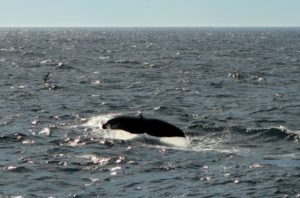Previously: Northern Norway: Lofotens
Day 5:
Waking up with the sound of rain over the tent… beloved Norway… Today, whales, seals and seabirds on the menu! The boat trip is really expensive (Artic Whale Tours, 800NOK, ~100€), but for sure I did not have any regrets. One of the holidays highlights for sure.
Very professional, friendly and experienced staff. Small presentation before getting on the boat about what we may encounter today, drug distribution for sea-sickers, and we’re on the boat. First stop close to a bird island: 15000 atlantic puffins, black guillemot, two white-tailed eagles, and lots of seagulls. A couple of harbor seals are bath-sunning on the island too. As the puffins live into small terrier, and with such a high density, one cannot walk on the island as the ground would collapse… Amazing trip, and the day is still young! (Would have been perfect without the rain!)
Power up the boat, heading north to the canyon, two hours ride, 3000m deep, lots of fishes, whale restaurant they said! It’s not uncommon to see killing or sperm whales there. On the way, the sea is doing its work, 90% of the boat is seasick, drugs or not. The friendly staff is helping out, distributing lovely green plastic bags… The garbage is filling up quickly! I think I can escape that part of the trip, for now. Arrival on the canyon (The sea is still flat in surface, we trust them!)… First sperm whale on sight! Full speed facing wind and waves toward it (that’s when I did not escape the green plastic bag).
Sperm whale: reach the surface every 30 minutes, stays there for 6-8 minutes to refresh its oxygen. Head out the water, breathing deeply, then dipping the head, rounds the back, say bye with its tail, and sink almost vertically down to the kitchen (canyon). Called “sperm” whale because of the liquid (still unsure of its function today) in its head (maybe used as a ballast?). During the half hour, it uses sonar waves to get directions and information about the food potential. Our boat tracks passively these waves to stay close to the whale. When it gets out, full speed again to get closer, whatever the waves and the wind. Hang strongly to the boat! Every whale is listed and studied (the boat staff includes 2 PhDs studying whale behavior), identified by its tail (shape, white marks, …).
After two hours in the area, timing to go back to the around, with hot sea-fish soup (your stomach might not be ready for that after the day spent rolling), and day pictures projection, with lots of explanations about the birds, their life here, how to identify them, … and a nap, well deserved!
7pm, landing finally, exhausted, stinking and starving but with a mind full of amazing pictures. Road to and night in Sortland. What a day!
To be continued: Northern Norway: Fjords and beyond

